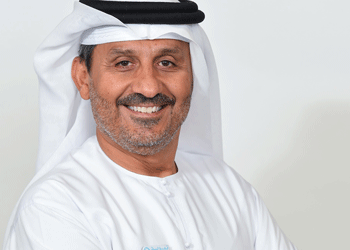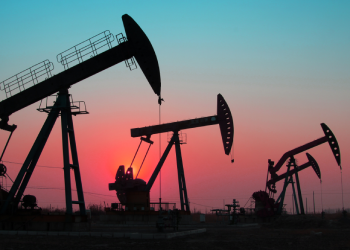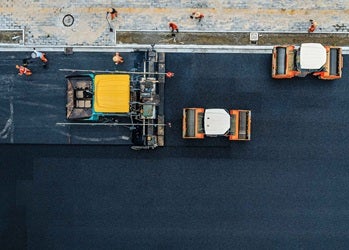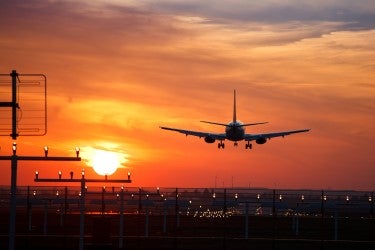Acwa Power taps artificial intelligence
14 October 2024
Riyadh-headquartered utility and green hydrogen developer and investor Acwa Power has topped MEED’s annual power and water developer ranking over the past few years.
The company’s portfolio, which it values at approximately $94bn, includes 49 thermal and renewable energy power plants and about a dozen water desalination plants.
These assets can generate 65GW of power and 8 million cubic metres a day of desalinated water.
Acwa Power continues to bid and win new contracts at home and abroad under Marco Arcelli, who was appointed as the firm’s chief executive shortly after Paddy Padmanathan, the firm’s CEO for 18 years, stepped down in March last year.
The company has tapped artificial intelligence (AI) and the stacks of technologies behind it to enable its future strategy, notes Thomas Altmann, the company’s executive vice-president for innovation and new technology.
“At Acwa Power, we are not talking about AI, we are doing it,” says Altmann, who cites that the company has developed an in-house algorithm to enable an augmented AI or human-in-the-loop (HITL) AI application.
Through this application, a plant operator may receive data or advice from an AI-enabled module that can trigger a response after the data is validated through the operator’s experience.
“We are focusing on human-in-the-loop, under the umbrella of collective intelligence … this in-house artificial neural network (ANN) algorithm has so far contributed to about 12% cost reduction of chemical dosing in one of our water desalination plants, which encourages us to industrialise this technology and implement it in selected plants,” explains Altmann.
“I think generally that AI is not stoppable; we’re not using it as a buzzword; we are focusing very much on use cases that make sense and create bottom-line impact.”
Analytics and machine learning
Acwa Power has been at the forefront of innovations not just in operating its plants but in winning tenders by proposing the use of new technologies.
“Over the past decade, we managed to reduce power consumption in our desalination plants by over 80%,” notes Altmann.
“I recall in 2005 when Acwa Power submitted the first bid, most of the desalination plants that were built during that period were based on thermal water desalination technologies such as MSF.”
However, things changed when Saudi Arabia tendered the Shuqaiq 2 independent water and power project (IWPP), which, for the first time, did not prescribe a specific technology for the project’s desalination unit.
There are a lot of things that typically are not discussed, like having to write new procedures to distinguish tasks that can be done by robots, algorithms and humans
“This allowed Acwa Power to innovate and deploy for the first time a membrane-based desalination technology at scale in Saudi Arabia. We were the only consortium that offered to build a 100% reverse osmosis plant in combination with a power plant (IWPP). Our bid was successful by offering 17% to 19% lower tariff due to significantly lower energy consumption compared to an MSF plant,” Altmann said.
Several years later, with the Rabigh 3 independent water project, the offtaker specified a drastically reduced energy consumption. Altmann said they “had to press the reset button, turn every stone and create a paradigm shift in RO design to meet these requirements”.
At this point, Acwa Power has used the so-called Typical Meteorological Year (TMY) methodology for renewable energy to predict future power generation in solar plants.
Altmann subsequently introduced a similar Typical Seawater Year (TSY) methodology, which used the previous five years’ worth of seawater data, used big data analytics to understand seawater resources, and designed their plant according to this result.
“This contributed significantly to our successful bid because we used real data rather than assumed data based on the request for proposals and implemented several design improvements, which resulted in the lowest ever specific energy consumption for RO in the region,” the executive noted.
Altmann says Acwa Power also introduced the so-called pressure centre in an RO plant in Saudi Arabia, where a high-pressure pump in a desalination plant is not necessarily linked to one reverse osmosis (RO) train. Instead, a pipe connects the pump and the racks, and each pipe can fit any rack. This allows fewer and larger pumps to be used and improves efficiency.
“Rabigh 3 was a breakthrough, and we continued to further optimise the process, and the results were applied, for example, in Taweelah in Abu Dhabi and Jubail 3A in Saudi Arabia.
“We added a solar component to the Taweelah IWP as an innovation and we continued to fine-tune and optimise as we move forward.”
Altmann also says they were the first to introduce machine learning to reduce chemical costs and predict the optimal time for membrane cleaning in RO desalination plants in the region.
The goal is to continue innovating into the future, says Altmann, citing their research and development (R&D) centres in leading universities across the GCC, in particular at the King Abdullah University of Science and Technology in Saudi Arabia, where they operate centres of excellence focusing on water, solar, hydrogen and AI.
AI and the future of utility jobs
While a fully autonomous water desalination plant may still be a few years away depending on how fast AI technologies develop, Altmann acknowledges that future plants will have fewer people on the floor.
This does not necessarily mean large-scale staff displacement since “we keep winning new plants, and we can reassign and retrain or reskill our staff.”
“As some jobs disappear, new jobs will be created,” adds Altmann. “There are many opportunities to utilise experienced people.”

The executive, however, cautions that AI deployment in a company is not just a matter of installing software codes.
It requires a change in culture and processes, particularly in HR, where one has to move away from thinking of employees’ positions or jobs but rather their tasks.
“One needs to distinguish which tasks require a lot of data, and involve routines, and which can be done by an algorithm, versus tasks involving creativity, human interaction or validation against ethical standards or privacy compliance and so on.”
“There are a lot of things that typically are not discussed, like having to write new procedures to distinguish tasks that robots, algorithms and humans can do,” he continues.
The executive also cites the paramount importance of the quality of data and the AI readiness of the Internet of Things (IoT) system to enable AI applications.
“The most important thing, besides ethics and privacy, from a technical perspective, is data. If you want a high-quality prediction or an advisory module, you need to put most of your effort into the data first.
“Utilising an algorithm … that’s the easy part, the difficult one is to get clean data, eliminate bias, noise and spurious correlations and consider differential shifts in the training of data since AI works differently to a human brain. AI doesn’t have an intuition or awareness to sense biases and is susceptible to providing wrong predictions,” explains Altmann.
Renewable-powered desalination plants
Altmann argues that if green hydrogen can be produced using 100% renewable energy, the same can be applied to water production.
Acwa Power built a 20MW solar PV to complement the grid-sourced electricity supply for the Taweelah IWP in Abu Dhabi because, according to Altmann, the RFP did not disallow it.
They are looking at doing more of these projects where it makes sense from a sustainability and efficiency point of view.
“The (Taweelah) RFP did not disallow the installation of a solar PV, and there was an available space, so we went ahead to build an on-site solar PV farm, which allowed us to reduce more expensive energy import from the grid.”
Altmann asserts that desalinated water can have a zero-carbon footprint by building captive water desalination plants or sourcing clean energy from the grid.
However, moving to a 100% renewable source will increase the complexity of building desalination plants.
“There’s a difference from a technical perspective if you take power from the grid, which has certain stability and inertia and is often linked to power plants.
“You will need to redesign the desalination plants differently, with a different operation strategy and different motors, and to deploy long-duration energy storage due to intermittency of renewable energy,” he concludes.
Exclusive from Meed
-
 Tabreed finishes the year on a high
Tabreed finishes the year on a high17 December 2025
-
 Kuwait Oil Company seeks higher project budgets
Kuwait Oil Company seeks higher project budgets17 December 2025
-
 Morocco awards $185m Guercif-Nador road contracts
Morocco awards $185m Guercif-Nador road contracts17 December 2025
-
 Egypt plans $5.7bn oil and gas exploration campaign
Egypt plans $5.7bn oil and gas exploration campaign17 December 2025
-
 Saudi Arabia to award Abha airport expansion by March
Saudi Arabia to award Abha airport expansion by March17 December 2025
All of this is only 1% of what MEED.com has to offer
Subscribe now and unlock all the 153,671 articles on MEED.com
- All the latest news, data, and market intelligence across MENA at your fingerprints
- First-hand updates and inside information on projects, clients and competitors that matter to you
- 20 years' archive of information, data, and news for you to access at your convenience
- Strategize to succeed and minimise risks with timely analysis of current and future market trends

Related Articles
-
 Tabreed finishes the year on a high
Tabreed finishes the year on a high17 December 2025

Tabreed is consolidating its position as a leading regional district cooling provider following a series of major transactions and new concessions that will reshape its portfolio in the UAE and beyond.
In 2025, the company completed the AED3.87bn ($1bn) acquisition of PAL Cooling Holding (PCH) in consortium with CVC DIF, and finalised the long-term district cooling concession for Palm Jebel Ali in Dubai as part of a joint venture (JV) with Dubai Holding Investments.
The PCH deal will eventually add about 600,000 refrigeration tons (RT) of capacity across eight long-term concessions in Abu Dhabi, raising Tabreed’s total connected capacity by 13% to 1.55 million RT. The AED1.5bn Palm Jebel Ali JV will ultimately deliver a further 250,000RT.
Speaking to MEED, Tabreed CEO Khalid Al-Marzooqi outlined how the company is integrating the newly acquired brownfield assets, developing greenfield projects and advancing a new generation of sustainable cooling solutions, including geothermal energy for data centres.
Tabreed’s recent milestones span both greenfield and brownfield investments, each requiring a different approach, says Al-Marzooqi.
Greenfield projects, such as Palm Jebel Ali, remain Tabreed’s preferred route for new capacity, he adds. “The beauty of a greenfield is that you can optimise it the way you want. You build it as you want.”
For new plants, Tabreed designs the civil structure to accommodate long-term capacity, while phasing in mechanical equipment in line with demand. By contrast, the acquisition of PCH is a large-scale brownfield integration, bringing in a portfolio of existing and future plants and networks, mainly on Abu Dhabi’s main island and Reem Island.
The immediate focus is on integration and driving network synergies. “That’s the beauty of district cooling. If you achieve the synergies, the benefits literally double up and triple up as well,” Al-Marzooqi says.
By interconnecting plants, Tabreed can avoid building for peak capacity at each individual site and instead leverage shared spare capacity across the network.
Growth strategy
Acquiring a competitor in Abu Dhabi is part of a strategy to sustain growth in a sector where many contracts follow build-own-operate-transfer or similarly time-bound models.
Organic growth via new concessions and inorganic growth via acquisitions are both seen as key to maintaining and expanding the asset base.
Tabreed’s portfolio remains weighted towards the UAE, with the home market accounting for the bulk of its business.
Beyond the UAE, Tabreed has built a regional presence, with a partially owned business in Saudi Arabia, where it sees significant growth potential as district cooling is integrated into gigaprojects and major urban developments; a wholly owned operation in Bahrain; and a majority stake in Tabreed Oman, a market that Al-Marzooqi says is expanding well.
Despite the energy and lifecycle cost benefits of district cooling, Al-Marzooqi says tariff subsidies on conventional, building-level cooling are a barrier to adoption in parts of the UAE.
“The killer for us is subsidy,” he says, explaining that artificially low tariffs for individual customers make it harder for district cooling to compete on price in Abu Dhabi compared to Dubai.
He says that policy support and regulatory mandates are needed, particularly as existing buildings approach the end of life for their standalone cooling systems. At that point, compulsory connection to district cooling could lock in significant energy savings and emissions reductions at city scale.
Raising Abu Dhabi’s district cooling penetration from about 15% towards Dubai’s estimated 30% remains a key concern and strategic objective.
In Abu Dhabi, Tabreed has developed … the Middle East’s first geothermal-powered district cooling plant
Geothermal breakthrough
Alongside portfolio growth, Tabreed is investing in new technologies to decarbonise cooling, with a focus on large campuses, major developments and, increasingly, data centres.
At Masdar City in Abu Dhabi, Tabreed has developed what Al-Marzooqi describes as the Middle East’s first geothermal-powered district cooling plant.
“We have started off by building the region’s first geothermal plant, to prove the concept of using geothermal energy to provide cooling,” he says.
The pilot plant is already achieving efficiency levels in the range of 0.5-0.6 kilowatts per ton (kW/ton) of cooling, better than Tabreed’s typical district cooling benchmark of about 0.85kW/ton. Conventional, standalone cooling systems generally consume about twice as much energy per ton.
“This is proof that if you really want to pursue a sustainable cooling solution for data centres in this area, this is the one,” he says.
Data centres are emerging as a priority growth segment for Tabreed. The facilities have high, continuous cooling loads and increasingly stringent decarbonisation requirements, making them a natural fit with both district cooling and geothermal systems.
Al-Marzooqi says geothermal cooling is a “godsend solution” for data centres, combining 24/7 availability with the potential for near-zero operational emissions.
For hyperscale and colocation data centre operators facing mounting pressure to reduce their carbon footprint, geothermal district cooling could offer a differentiated, long-term solution in the Gulf region, particularly where grid power is still largely fossil-fuel based.
Tabreed’s technology agenda is not limited to low-carbon generation. The utility is in the second phase of connecting its plants to a centralised digital control centre, enabling remote operation and optimisation.
The long-term goal is for the majority of plants to be unmanned, with operations centrally monitored and controlled. This integrated view of the network will enable the application of artificial intelligence and advanced analytics to fine-tune performance, optimise energy use and predict maintenance requirements.
https://image.digitalinsightresearch.in/uploads/NewsArticle/15266676/main.gif -
 Kuwait Oil Company seeks higher project budgets
Kuwait Oil Company seeks higher project budgets17 December 2025

Contractors in Kuwait expect to have answers by the end of the year on whether budgets for several key upstream projects in the oil and gas sector will be increased, according to industry sources.
State-owned upstream operator Kuwait Oil Company (KOC) is seeking approvals for at least three upstream projects, for which bids came in significantly over budget.
The first project, with a low bid of $2.47bn, involves the development of two facilities: Separation Gathering Centre 1 (SGC-1) and Water Injection Plant 1 (WIP-1).
The second project, with a low bid of $2.48bn, focuses on developing SGC‑3 and WIP‑3.
The third project, which involves developing effluent water disposal plants for injector wells, had a low bid of $1.3bn.
For KOC to increase the budgets for all three projects, approvals will be required from Kuwait Petroleum Corporation (KPC) and the country’s Ministry of Finance.
Already cancelled
One Kuwaiti oil project tender that received bids significantly above budget has already been cancelled.
On 7 October, MEED reported that the tender for the SGC-2 oil project – focused on the installation of a separation gathering centre – was cancelled by Kuwait’s Central Agency for Public Tenders.
Earlier this year, UK-based Petrofac had submitted a bid more than double the project’s proposed budget.
Petrofac’s bid was KD422.45m ($1.37bn), while the provisional budget stood at KD207m ($670.2m).
This contract is expected to be retendered, but there is significant uncertainty about when a new invitation to bid will be issued and how the scope may change.
Earlier in December, MEED reported that KOC was discussing whether to retender the contract using a different contract model.
Initially, the project was tendered using the engineering, procurement and construction (EPC) contract model.
Discussions are ongoing on whether it will be relaunched under a build-own-operate (BOO) contract model.
https://image.digitalinsightresearch.in/uploads/NewsArticle/15263996/main.png -
 Morocco awards $185m Guercif-Nador road contracts
Morocco awards $185m Guercif-Nador road contracts17 December 2025

Morocco’s Ministry of Equipment, Transport, Logistics & Water has awarded three contracts totalling MD1.7bn ($185m) for building three lots of the 40-kilometre (km) section two of the Guercif to Nador highway between Saka and Driouch.
The contracts were awarded to local firms.
Casablanca-based Groupe Mojazine won a $64m contract for lot one, which covers the construction of 14km of highway.
The other two contracts covering construction works on lots two and three were awarded to the local firm Bioui Travaux.
The contract value for lot two is over $56m and covers the 12km highway section. The lot three contract is worth about $69m and covers 40km of highway construction.
The 104km Guercif to Nador highway is being implemented in three sections. Prequalification for section two from Saka to Driouch was completed in June, as MEED reported.
The estimated $700m project, partly funded by the African Development Bank, is part of the kingdom’s plans to upgrade its public infrastructure in preparation for co-hosting the 2030 Fifa World Cup alongside Portugal and Spain. The programme includes the expansion of over 1,000km of highways.
In May, Societe Nationale des Autoroutes du Maroc awarded MD5bn ($540m) of contracts for nine packages covering construction works on the Rabat-Casablanca continental expressway.
Morocco’s construction and infrastructure sector is gearing up for billions of dollars in projects as the North African nation continues to award contracts for building infrastructure for the 2030 Fifa World Cup.
Morocco has made a strong head start in ensuring that the necessary infrastructure is ready for the tournament.
According to data from regional project tracker MEED Projects, 2024 was the best year in the past decade for construction and transport contract awards in Morocco, with contracts worth over $3.6bn signed with local construction firms and international companies from South Korea, China, France and Spain.
https://image.digitalinsightresearch.in/uploads/NewsArticle/15266606/main.jpg -
 Egypt plans $5.7bn oil and gas exploration campaign
Egypt plans $5.7bn oil and gas exploration campaign17 December 2025
Egypt plans to drill 480 exploratory wells, with total investment estimated at $5.7bn, over the next five years, according to Karim Badawi, the country’s minister of petroleum and mineral resources.
Speaking at a conference in Cairo, Badawi said that Egypt’s oil and gas sector was stabilising after a period of decline.
He said that his ministry was targeting an increase in gas production for the first time in four years.
The government is also aiming for self-sufficiency in crude oil production within five years, he said.
Egypt is aiming to boost crude production by introducing investment incentive packages and utilising new production technologies.
Badawi highlighted specific capital commitments from international partners to develop oil and gas resources over the next five years. These included Italian company Eni’s commitment to invest $8bn, as well as London-headquartered BP’s plan to invest $5bn.
He also highlighted Arcius Energy’s plan to invest $3.7bn. Arcius Energy is a joint venture of BP and Adnoc’s XRG.
The $5.7bn exploration programme includes 101 wells scheduled for drilling in 2026.
Badawi said that seismic survey operations would expand to cover 100,000 square kilometres in the Western Desert and 95,000 square kilometres in the Eastern Mediterranean using Ocean Bottom Node (OBN) technology.
Renewable energy strategy
Addressing the national energy strategy, Badawi said the government aims to increase the share of renewable energy in electricity generation to 42% by 2030.
He said this would enable natural gas to be redirected to value-added industries, such as petrochemicals and fertilisers, to boost exports.
On the transition to green energy, the minister cited plans to reduce reliance on traditional fuels and open investment in sustainable aviation fuel (SAF), green ammonia and bioethanol.
Efficiency measures in the sector have already reduced carbon emissions by 1.4 million tonnes, he said.
Recently, Egypt announced a $200m deal with Qatar to produce aviation fuel from used cooking oil.
https://image.digitalinsightresearch.in/uploads/NewsArticle/15264077/main0508.jpg -
 Saudi Arabia to award Abha airport expansion by March
Saudi Arabia to award Abha airport expansion by March17 December 2025
Register for MEED’s 14-day trial access
Saudi Arabia’s Civil Aviation Holding Company (Matarat) and the National Centre for Privatisation & PPP (NCP) are expected to award the contract to develop and operate a new passenger terminal building and related facilities at Abha International airport by March next year.
The announcement was made by Abdulaziz Al-Duailej, president of the General Authority of Civil Aviation (Gaca), at the Supply Chain and Logistics Conference 2025 in Riyadh on Tuesday.
The companies prequalified to bid for the contract are:
- GMR Airports (India)
- Mada TAV: Mada International Holding (local) / TAV Airports Holding
- Touwalk Alliance: Skilled Engineers Contracting (local) / Limak Insaat (Turkiye) / Incheon International Airport Corporation (South Korea) / Dar Al-Handasah Consultants (Shair & Partners, Lebanon) / Obermeyer Middle East (Germany/Abu Dhabi)
- VI Asyad DAA: Vision International Investment Company (local) / Asyad Holding (local) / DAA International (Ireland)
Located in Asir Province, the first phase of the Abha International airport public-private partnership (PPP) project will expand the terminal area from 10,500 square metres (sq m) to 65,000 sq m.
In early March this year, the clients held one-on-one meetings with prospective bidders in Riyadh, as reported by MEED.
The contract scope includes a new rapid-exit taxiway on the existing runway, a new apron to serve the new terminal, access roads to the new terminal building and a new car park area.
Additionally, the scope includes support facilities, such as an electrical substation expansion and a new sewage treatment plant.
Construction is scheduled for completion in 2028.
The project will be developed under a build-transfer-operate (BTO) model and involves designing, financing, constructing and operating a greenfield terminal.
This will be the kingdom’s third airport PPP project, following the Hajj terminal at Jeddah’s King Abdulaziz International airport and the $1.2bn Prince Mohammed Bin Abdulaziz International airport in Medina.
Higher capacity
According to Matarat, Abha airport’s capacity will increase to accommodate over 13 million passengers annually—a 10-fold rise from its current 1.5 million capacity.
Once completed, the airport will handle more than 90,000 flights a year, up from 30,000.
The new terminal is also expected to feature 20 gates and 41 check-in counters, including seven new self-service check-in kiosks.
The BTO contract duration is 30 years.
The existing terminal, which served 4.4 million passengers in 2019, will be closed once the new terminal becomes operational.
Matarat’s transaction advisory team for the project comprises UK-headquartered Deloitte as financial adviser, ALG as technical adviser and London-based Ashurst as legal adviser.
https://image.digitalinsightresearch.in/uploads/NewsArticle/15264715/main.jpg

